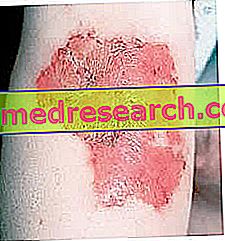Generality
Spinocellular carcinoma is a malignant tumor of the skin, which affects the squamous cells of the epidermis.

Figure: cutaneous lesion associated with spinocellular carcinoma. From the site: www.surgicalnotes.co.uk
In most cases, it is caused by excessive exposure to UV rays from the sun or abuse of tanning lamps.
Its onset causes the appearance of a skin wound, with different connotations depending on the patient in question.
If diagnosed early, spinocellular carcinoma is generally treated successfully; if complications arise, it is because the tumor has arisen in a delicate part of the body or because the patient is a "fragile" individual and more prone to skin cancer than others.
If the necessary precautions are taken, it is possible to prevent it.
What is spinocellular carcinoma?
Spinocellular carcinoma is a malignant tumor of the skin, different from melanoma, which originates in the squamous cells of the epidermis.
Generally, it is not a very aggressive tumor, but it can become one and cause various complications when it occurs in certain areas of the body or when it is not treated properly.
Spinocellular carcinoma has several synonyms: in fact, it is also called squamous carcinoma, squamous cell carcinoma, squamous cell epithelioma or spinalioma .
What are squamous cells?
Squamous cells are more or less subtle cellular elements, which are found in the outer layers of the skin, precisely in the epidermis .

Squamous cells belong to the family of so-called keratinocytes, which are the cells that produce keratin .
SKIN CANCER OTHER THAN MELANOMA
Skin cancers other than melanoma (or non-melanomatous skin tumors ) are the most common neoplasms of the skin, and among the most common in general. The common element is the involvement of the most superficial layers of the skin; what differentiates them is instead the type of cell affected by the neoplasm.
The most common non-melanomatous skin tumors are two carcinomas: the spinocellular one, of which we are talking, and the basal cell, also known as basocellular epithelioma .
Epidemiology
Skin cancers other than melanoma . Spinocellular carcinoma and basal cell carcinoma represent, respectively, 20% and 75% of all skin cancers other than melanoma (the remaining 5% is shown in the table). This means that, out of 10 skin cancer patients other than melanoma, 2 suffer from squamous carcinoma and 7/8 basal cell carcinoma (what is left over is the remaining 5%).
The remaining 5% of non-melanoma skin cancers consist of:
- Merkel cell carcinoma
- Cutaneous T-cell lymphoma
- Cutaneous B-cell lymphoma
- Carcinoma of the sebaceous glands
- Kaposi's sarcoma
- Dermatofibrosarcoma protuberans

Figure: a basal cell carcinoma compared to a spinocellular one. From the site: www.veteranstoday.com
In Italy, the calculated annual incidence is equal to 100-105 cases per 100, 000 inhabitants.
Spinocellular carcinoma . Squamous cell carcinoma usually occurs in old age (around 60 years) and is more frequent among men, rather than among women. Its annual incidence varies according to the geographic area considered, as it increases the closer you get to the equator and / or you are at high altitude. As regards Italy, the calculated annual incidence is equal to about 22-23 cases per 100, 000 individuals.
Causes
What is a tumor?
A tumor is the result of an out-of-control cellular multiplication triggered by one or more DNA genetic mutations. In other words, when DNA undergoes certain changes and these changes are irreparable, then the cells that contain it undergo excessive and unstoppable growth and division.
In the case of spinocellular carcinoma, the cells that multiply uncontrollably (due to one or more genetic errors of DNA) are the squamous cells of the epidermis. Such cells, in a healthy individual, are born, grow and die in an orderly manner; in an individual suffering from spinalioma, however, they reproduce without any control, altering the normal process of cellular exchange that takes place on the surface of the skin.
WHAT IS THERE ABOUT THE ORIGIN OF DNA CHANGES?
DNA mutations, which lead to the formation of most spinocellular carcinomas, occur due to exposure to ultraviolet radiation ( UV rays ) of the sun and tanning lamps.
The genetic changes, which do not have this origin, however, are explained by an unusual contact between the patient and certain toxic substances, or with a too weak immune system .
RISK FACTORS
Several circumstances have been identified that favor the appearance of squamous carcinoma. These risk factors consist of:
- Light skin . Anyone can get spinocellular carcinoma, regardless of skin color. However, those with less melanin (ie the skin pigment that protects us from UV rays) are more predisposed than those who have more. Therefore, people with very light skin, who get sunburned easily (due to the scarcity of this pigment) are at high risk.
- Too much sun . Exposing yourself too much to the UV rays of the sun, even if you do not have a fair skin, has a decisive effect on the appearance of squamous carcinoma and any other skin cancer, favoring it.
- Excessive exposure to tanning lamps . Tanning lamps emit the same ultraviolet radiation as the sun, so excessive use of them has the same effects as the latter.
- History of severe sunburn . Who in the past has been the protagonist of severe sunburn is more at risk than those who, on the other hand, have always adequately protected themselves.
- Personal history of precancerous skin lesions . Those who suffer from actinic keratosis or Bowen's disease, or two pre-cancerous skin lesions, are more at risk of getting sick than healthy people.
- Personal history of a previous skin cancer . Individuals affected in the past by the same or another skin cancer are at greater risk of relapse.
- Weak immune system . An individual's immune system is its defensive barrier against infections and other threats brought by the external or internal environment. When this defense is ineffective, it predisposes to various disorders, including skin cancers. An emblematic case, of what has just been said, is represented by patients with leukemia or lymphoma and organ transplants, who - being forced to suppress, with appropriate drugs, their own immune system - expose themselves to infectious diseases and, precisely, to skin cancer.
- Genetic predisposition . People with xeroderma pigmentosum are extremely sensitive to sunlight, therefore they are predisposed to all known skin cancers, including spinocellular carcinoma. The incidence in these subjects is very high, so much so that they must protect the skin even when they are in their homes.
Symptoms and Complications
To learn more: Symptoms Squamous cell carcinoma)
Spinocellular carcinoma manifests itself with a distinctive cutaneous sign .
This sign can appear anywhere (therefore also in the mouth, genitals and anus); however, in most cases, it appears in the areas of the body most exposed to the sun, such as the scalp, back of the hands, face and ears. Its characteristics vary from person to person, so that it could look like:
- A red nodule, with a rigid consistency
- A scaly and crusty plague
- An ulcerative lesion that never heals
- In the lips, an area with a rough and scaly appearance, which tends to become an open sore
- Inside the mouth, a sore with a rough and red surface
- In the genitals and anus, a wart
WHEN TO REFER TO THE DOCTOR
It is advisable to contact your dermatologist, if a cutaneous wound, which appears inexplicably in one part of the body, tends never to heal and to constantly reform itself.
COMPLICATIONS
If not treated in time and duty, spinocellular carcinoma could, in sequence, contaminate the surrounding healthy tissues, reach the lymph nodes and / or other internal organs (such as, for example, the liver) and eventually lead to death.
All these complications are more likely to occur if the spinocellular carcinoma:
- It involves the formation of a very large and deep wound or sore
- It arises at the level of the mucous membranes (for example, in the mouth or on the lips)
- It arises in an individual with an ineffective immune system
Diagnosis
To diagnose a spinocellular carcinoma, a physical examination and a tissue biopsy (ie suspect tissue) are required.
EXAMINATION OBJECTIVE
During the physical examination, the dermatologist examines the wound and questions the patient about his state of health and his medical history.
From the appearance of the wound, it can assess, at least in part, the severity of the tumor; from the medical history and from the state of health, instead, he can understand if the individual under examination is potentially a subject at high risk of spinocellular carcinoma or not.
BIOPSY
The biopsy is the only diagnostic check able to establish the true nature of the wound, present on the skin, and, in the case of a tumor, the type of neoplasm.
This examination involves taking a small piece of tissue directly from the suspected skin area and observing it under a microscope. To the instrument, any tumor cells present have an unmistakable appearance.
Treatment
The only way to cure a spinocellular carcinoma is to completely remove the skin wound. Removal can take place with different methods, depending on the location, size and aggressiveness of the tumor. Here are the various therapeutic techniques that can be used to remove squamous carcinoma:

- Laser therapy . An intense beam of bright light is "fired" directly at the skin area affected by the tumor. This has the power to vaporize the tumor sore, without damaging the surrounding tissue areas too much and without causing excessive blood loss. It is the ideal solution for superficial spinocellular carcinomas.
- Cryotherapy . It is the cold therapy ("crio" comes from the Greek and means "cold"). It consists in applying liquid nitrogen to the affected area. Liquid nitrogen freezes the cells of the tumor tissue and kills them. It is a good solution for superficial squamous carcinomas.
- Photodynamic therapy . It involves the use of a photosensitizing drug, for topical use, and a source of luminous radiation. The photosensitizing drug is a kind of cream, which, applied to the tumor area, makes the latter more sensitive to light; the light source, on the other hand, emits light, which serves to destroy tumor cells, which have become hyper-photosensitive after the application of the drug.
- Topical drugs . There are several creams and lotions containing anticancer drugs. these, once smeared on the affected area, destroy the cancer cells.
- Surgical excision (or excision) . It is the surgical removal, by incision, of the tumor lesion present on the skin. The biggest risk with this procedure is leaving a skin scar, especially in delicate areas such as the face.
- Mohs surgery . It is the elimination of the neoplastic plague by small layers. Examining each layer removed from the microscope from time to time, the surgeon knows when the spinocellular carcinoma has been completely eliminated. This procedure, since it ends with the removal of the first layer without tumor cells, guarantees the exclusive removal of the tumor, without unduly compromising healthy tissues.
- Radiotherapy . It involves the use of a source of high-energy X-rays, which, projected onto the tumor area, kill the neoplastic cells. It is not always effective, as relapses can occur. It is applied especially in the case of very deep scaly carcinomas.
Prognosis and prevention
If the tumor is diagnosed and treated in time, and if you do not suffer from particular disorders (for example xeroderma pigmentoso), spinocellular carcinoma is a malignant neoplasm from which you can heal.
However, complications may occur, for example if the tumor is severe and deep or if it has appeared in an uncomfortable anatomical point (face, mouth, genitals, etc.).
The prognosis, therefore, depends not only on the timeliness of care, but also on the characteristics (site, size, severity, etc.) of squamous carcinoma.
PREVENTION
Spinocellular carcinoma is a cancer that can be prevented by following certain recommendations. Here are the main ones:
- Avoid exposing yourself too much to the sun in the central hours of the hottest days . In these moments, in fact, UV radiation is remarkable and highly damaging to the skin.
- Use sun protection creams . Their use is particularly advocated for fair-skinned individuals who are at sea, those who work outdoors and people at high risk of skin cancer (people with a weakened immune system, people with xeroderma pigmentosum) etc).
- Cover the parts of the body that are usually most exposed to sunlight and wear sunglasses . For both of these suggestions, the same is true in the case of sunscreens: they must be followed by everyone, but especially by certain people most at risk.
- Do not abuse tanning lamps or, better, avoid using them . Its use is not strongly recommended especially for those who have fair skin or are predisposed to skin cancer.
- Check your skin periodically . It is good to examine, from time to time, the whole body, even the most unthinkable points (genitals, between the toes, etc.). It may be useful to obtain more mirrors, so as to inspect even the most hidden or invisible parts of the body.
- Do not neglect any skin abnormality, which appears suddenly, because it could be a spinocellular carcinoma or any other skin cancer.




